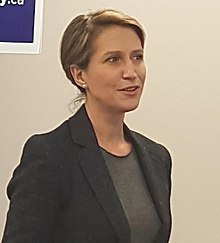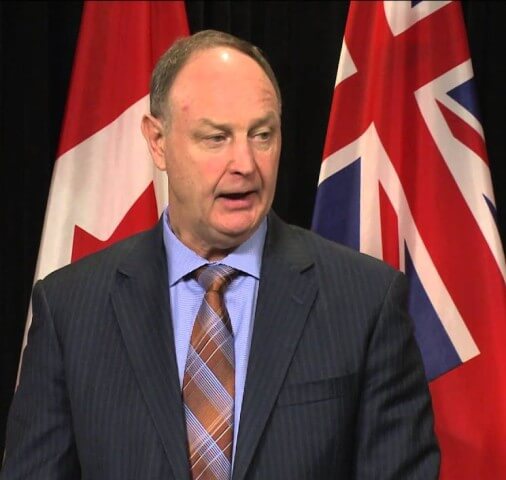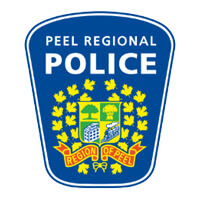Minister Caroline Mulroney’s Speech at the Toronto Region Board of Trade
The Voice of Canada News:
Caroline Mulroney, Minister of Transportation delivered the following remarks to the Toronto Region Board of Trade:
I want to take a moment to acknowledge the leadership on this issue demonstrated by the Toronto Region Board of Trade.
You, and your members, should be proud of your ongoing efforts to promote big ideas to solve gridlock and promote transit expansion in the Greater Toronto and Hamilton Area.
Solving this challenge requires governments, businesses and thought-leaders working together.
We won’t always agree, but we must always be working collaboratively on shared goals.
And the Toronto Region Board of Trade demonstrates that spirit of productive collaboration.
Thank you.
I also want to acknowledge some important colleagues and partners in the room this morning:
My Cabinet colleagues, including Associate Minister of Transportation Kinga Surma. Kinga’s knowledge of Toronto transit policy and municipal affairs has been critical to my first 100 days as Minister of Transportation.
My Parliamentary Assistant for Transportation, and a transit champion for the people of Scarborough, Vijay Thanigasalam. Thank you, Vijay.
My Parliamentary Assistant for Francophone Affairs, and my partner in championing transit for York Region, Gila Martow. Thank you, Gila.
I want to thank all of my other caucus colleagues who are joining us this morning. My caucus colleagues are relentless in supporting transit and transportation solutions for the residents of this region – including my caucus colleagues who represent constituencies outside the GTHA. They all recognize the importance of reducing gridlock and supporting economic growth in Ontario’s capital.
And I want to acknowledge our indispensable municipal partners, many of whom are in the room this morning.
Lastly, I want to acknowledge some key Ministry of Transportation and Metrolinx officials who are committed to improving transit, including Metrolinx Chair Don Wright and CEO Phil Verster.
Thank you all for joining me this morning.
This speech has many positive messages for residents and businesses in the Toronto Region. But there is one message every commuter in our region has been waiting to hear:
Finally, after years of discussion, the City of Toronto and the Province of Ontario are on the cusp of endorsing one single unified plan for subway expansion in Toronto.
I know everyone is gathered to hear me discuss the subway expansion plan endorsed earlier this week by Mayor Tory, key Councillors and the City of Toronto staff.
However, I want to take a few moments to widen the aperture and discuss our subway expansion plan within the context of our broader plans to improve transit across the GTHA.
This region needs faster, better transit. The GTHA powers the economy of Ontario – a province that is once again becoming the economic engine of Canada.
Across this region, people are trapped in gridlock – idling on highways, jammed on subway platforms or stuck in neighbourhoods without access to rapid transit. That’s opportunity squandered.
In the GTHA today, the average commute to-and-from work is 48 minutes.
The C.D. Howe institute says this region loses 11 billion dollars in productivity each year as a result of gridlock.
According to the Board of Trade, gridlock adds 400 million dollars to the cost of goods in the region.
That’s today. Without action it will only get worse as one million more people move into this region over the next 10 years.
This region needs more transit to cope with current gridlock and tomorrow’s growth.
I know, it’s popular to complain that “nothing is happening” with transit in this region. However, as a Conservative, I know that just because a notion is popular doesn’t mean it’s correct.
We are continuously improving GO Rail service. We are building towards the largest-ever GO Rail expansion.
We are building and procuring major new LRT projects that will fundamentally change the transportation experience for millions of people across the GTHA.
Ontarians expect better, faster transit service.
And it is happening. More service. More trains. More stations. More connections. And more convenience – especially throughout the day.
Improving transit means new construction, but it also means improved service.
Since being named your Minister of Transportation in June, I had the privilege of overseeing nearly 150 additional GO train trips, per week – 84 new trips and the extension of 65 existing trips.
Our government introduced daily commuter service from Niagara Falls and St. Catharines to Toronto – four years ahead of schedule.
Since last year GO Rail service has increased from nearly 2000 trips per week to almost 2400 trips per week. It’s a twenty-one percent increase. Since last year.
And there is more to come. Metrolinx, under the leadership of Don Wright and Phil Verster, is working to maximize service along each rail corridor owned by Metrolinx and negotiate further access along the rail lines owned by private railways.
Just recently, we purchased 36 more GO Rail cars. Those rail cars will be built right here in Ontario by workers in Thunder Bay. And those cars can be used to further expand GO Rail service.
We’ve added more GO Train service on the Kitchener Line, including more trains that go all the way, along the full route. In the past year, we doubled service to-and-from Kitchener. This provides better access to jobs at both ends of the innovation corridor between Kitchener-Waterloo and Toronto.
While GO Transit is best known for its rush hour commuter service, we believe it can offer people so much more. Demand for public transit is growing and we are offering more trips at more times of the day.
One of the first decisions our government made was to double the number of mid-day trips along the Lakeshore East and Lakeshore West lines.
For those of you who don’t leave the 416, ‘Lakeshore East’ and ‘Lakeshore West’ refer to the GO Rail lines that run from Oshawa to Union Station in the East, and from Hamilton to Union Station in the West.
Consider this – a GO rider in Ajax used to schedule her day around getting to the station to meet a train that departed only twice an hour. Now, if she needs to head into Toronto, she can show up at the Ajax GO station and anticipate a train every 15 minutes.
This is all part of our plan to encourage people to use transit all-day, every-day. We knew some people would take the train for mid-day trips, if the service was a little more convenient. Now, with more people on board, that’s been proven to be true.
We are making transit service better, and we are making it more affordable.
A few months ago, we launched Kids GO free! Children under 12 now travel free. Kids GO free! means more families are using GO Transit.
It’s a smart business plan to get more people filling our trains on weekends and holidays. Plus, it makes life more affordable for families and it encourages a life-long habit of using transit.
Adult fares are coming down, too. Rides of about 10 kilometres or less are now similar to the cost of riding the local bus or the subway.
That makes a ride downtown from Exhibition Place or Danforth more affordable and it directly contributes to reducing congestion in Toronto.
We are improving service and we are building an expanded GO Rail network.
Infrastructure Ontario, through the leadership of my colleague Laurie Scott, is now procuring a massive GO expansion program that will bring all day, two-way service, every 15 minutes to our network.
This will be a game changer.
Until this week, it was the largest transit expansion in our province’s history.
Our plan includes 6,000 weekly trips; two times as many rush-hour options; and, three times as many off-peak options along the whole GO Train network.
According to our team at Metrolinx, this plan will double the regional commuter capacity equivalent to nine new lanes on the 401. Consider that – our GO Rail expansion will add nine new 401 lanes.
We are solving gridlock.
Our plan will bring GO’s trains into the 21st century with more modern technology. New trains will reduce the average commute by 20 minutes, cost 30 per cent less to operate and be more environmentally friendly.
This kind of expansion does not happen overnight, but it is happening.
Large and small projects to facilitate this expansion are currently underway across the region.
Metrolinx will spend more than two-billion dollars this year directly on construction to support GO Rail expansion. It’s happening. And it will permanently change how we move around the region.
That’s a picture of what’s happening regionally. Locally, major new projects are in construction or procurement.
The Eglinton Crosstown LRT is in the homestretch and no, the Minister of Transportation doesn’t decide the road closures.
The Finch West LRT is under construction.
The Hurontario LRT in Mississauga and Brampton will begin construction in 2020.
The Hamilton LRT is in procurement.
Each of those projects is a multi-billion commitment that will add to a gridlock-busting network of transit options across the GTHA.
We are also working with the private sector on transit-oriented development. Our government has been advancing transit-oriented development since our election.
Private sector partners are building new stations at Mimico and in Rexdale. The Rexdale station will bring new transit to an employment area and create a connection to the North Campus of Humber College.
Transit-oriented development benefits taxpayers by encouraging the private sector to build transit infrastructure, but it’s also smart city-building. I want to thank Minister Surma for helping me to advance this priority.
All of those things are happening around Toronto now. Which, of course, brings me back to Toronto – and subways.
Subway construction is top a priority for commuters and for our Premier, Doug Ford.
Commuters and businesses in the GTHA will not be satisfied that traffic congestion is being addressed in our region, unless governments can demonstrate they are working together to build new subways.
In April, the Premier unveiled the largest subway expansion in Ontario history. Not one, not two, not three, but four new or expanded subway lines.
I am grateful the Premier asked me to assume the Transportation portfolio for our government and lead our subway discussion with the City of Toronto. In the past 100 days, I found a willing municipal partner that shares our goal of better, faster transit. Thank you, Mayor Tory.
I want to thank and acknowledge the City of Toronto officials and the Ministry of Transportation officials, including my own staff, who gave months of effort to arrive at Wednesday’s announcement.
The negotiations reminded me of my past life in financial markets, except ‘taxpayer’ replaced ‘shareholder’ and the overnight dinners couldn’t be charged to the client.
I particularly want to acknowledge the leadership of our Premier. Without Premier Ford, there wouldn’t be a plan to build four new subway projects and we would not be discussing a unified provincial-municipal plan.
This plan, and the willingness to work with our municipal partners, is a credit to the Premier.
On Wednesday, the report to council by City of Toronto officials endorsed our plans for four subway projects. I am grateful for the support of Mayor Tory and the supportive words from councillors.
As Mayor Tory said “This is our way forward. And the only way that we will ensure for this generation of Toronto residents and future generations that the transit actually gets built.”
In the last 48-hours, there has been a lot of discussion about the province’s proposal to keep the existing subway system as a responsibility of the city while our four new expansion projects will be the responsibility of the province.
Our goal was always expansion of the subway network for the benefit of all commuters – including the residents of York Region who will finally be connected to the Yonge subway line.
Our government has been willing to pursue all means to achieve our key objective: a better subway network.
Our campaign commitment to expand the subway network resulted in months of vigorous discussion between provincial and city officials. The outcome of that discussion is our current proposal to the city and this week’s report from city staff to city council.
The discussions over the past months demonstrated that we could achieve our commitment to expansion by working with the city while also addressing the modernization and enhancement of the existing system.
In order to guarantee the four projects are delivered rapidly and to ensure the new subway lines are integrated with the existing TTC system, the province is committed to working with the city to establish the best approach to manage key points of intersection between the existing and future lines, including with respect to the level of access and control required.
As you may also have noted through the news coverage, our proposal to the city includes provisions that could allow Toronto to flow billions of dollars into much-needed, state-of-good-repair projects for the existing network. A backlog the City of Toronto itself estimates at more than 30 billion dollars.
This is a win-win. New subways. Better subways.
Our subway plan, now endorsed by the province, Mayor Tory and city staff will bring subway infrastructure to new neighbourhoods across Toronto.
The Ontario Line will cover 15.5 kilometres, creating a new axis across the city centre, connected to the Osgoode, Queen and Pape subway stations, plus the future Eglinton Crosstown station at Don Mills.
We will finally have a new line to ease crowding on the Yonge subway. This new line will provide real relief, and finally bring subway service to neighbourhoods like Flemington Park, Thorncliffe and Liberty Village. And it can be finished by 2027.
The Yonge North subway extension will extend the Yonge Line to reach growing employment centres in Markham and Richmond Hill. And, it will provide much-needed connections to York Region Transit. As an MPP for York Region, I know the critical importance of this project.
The Eglinton Crosstown West extension will give more Etobicoke neighbourhoods subway access, and it enables future subway expansion right into Pearson Airport.
And, we will finally deliver the three-stop subway extension that Scarborough residents have been waiting for.
Ontarians want to see us get shovels in the ground, lay the tracks, buy the trains and deliver more transit.
I am confident city council will, later this month, concur with the Mayor and city staff and endorse this realistic plan. I look forward to working with Mayor Tory and his team to deliver subway expansion.
Our plan is ambitious, but it is attainable. Our government will make sure the new Ontario Line and the extensions are built – quickly. And we will do this, working collaboratively with the City of Toronto and the TTC.
I will not let bureaucratic red tape get in the way of building the subways Toronto needs.
I didn’t grow up in Toronto. I grew up in Ottawa – so I’m familiar with government red tape. But I spent my youth in New York – so I’m familiar with genuine subway networks.
My husband and I moved to Toronto because this is where we wanted to raise our children. Of course, we didn’t know how the distance between GTHL hockey arenas when we made that choice.
Jan – can the Board of Trade do something about siblings being scheduled to play in Etobicoke and Scarborough on the same night?
But I didn’t grow up in Toronto.
And because I didn’t grow up in Toronto, I’m not willing to accept the delays and excuses that have plagued Toronto subway construction since the golden era when Premier Frost opened the Yonge Line, Premier Robarts opened the Bloor-Danforth Line, and Premier Davis opened the Spadina Line.
Our government will continue to find ways to speed up transit construction. I know from speaking with Mayor Tory that he is committed to finding ways to build subways faster.
And I want to work with him.
My message to commuters is clear: our plan to build four priority subway projects is realistic, attainable and deliverable.
So, we have the plan and we have the will.
We are in. Mayor Tory supports this proposal. And, after October 30th, I am confident Toronto City Council will be in, too.
This week, we heard important statements from the federal parties. But, in this last weekend of the election campaign, GTHA commuters need to hear a firm commitment that both parties vying to form the next federal government will fully fund the federal share of Toronto’s subways.
I understand the Liberal Party has committed to supporting the priority projects identified by the City and the Province.
Conservative Party Leader Andrew Scheer has committed that a Conservative government will prioritize both the Ontario Line and the Yonge North subway extension.
He explicitly acknowledged that both projects will deliver “real relief.” I appreciate his strong commitment. Andrew Scheer understands the needs of this region and its importance to the national economy.
In Canada, the Federal government’s share of public transit infrastructure is 40 per cent. Both federal parties vying to form government expressed strong commitments to Toronto subways.
Commuters needs both parties to commit to assuming 40 per cent of the cost of Toronto’s four priority subway projects.
I am calling on the parties vying to form the next federal government to translate their commitments into an assurance that the next federal government will assume a 40 per cent share of Toronto’s four subway expansion projects.
Transit improvement and transit expansion is happening across our region. There is reason for great optimism.
We are finally making the smart, long-term investments to tackle gridlock and accommodate the tens of thousands of ambitious new neighbours we welcome to this region, every year.
There is reason for optimism, but I know GTHA commuters will never feel truly satisfied that governments are solving gridlock until the Government of Ontario and the City of Toronto are working together to build subways – that is why this week is so exciting.
We now have governments working together on a single plan for subway construction. And that is why we need a full commitment of 40 per cent from the next federal government.
We are building a truly integrated transit network across the Greater Toronto and Hamilton Area. It is happening.
I am grateful to be your Minister of Transportation at a time when real improvement for this region is happening.
Thank you very much.





